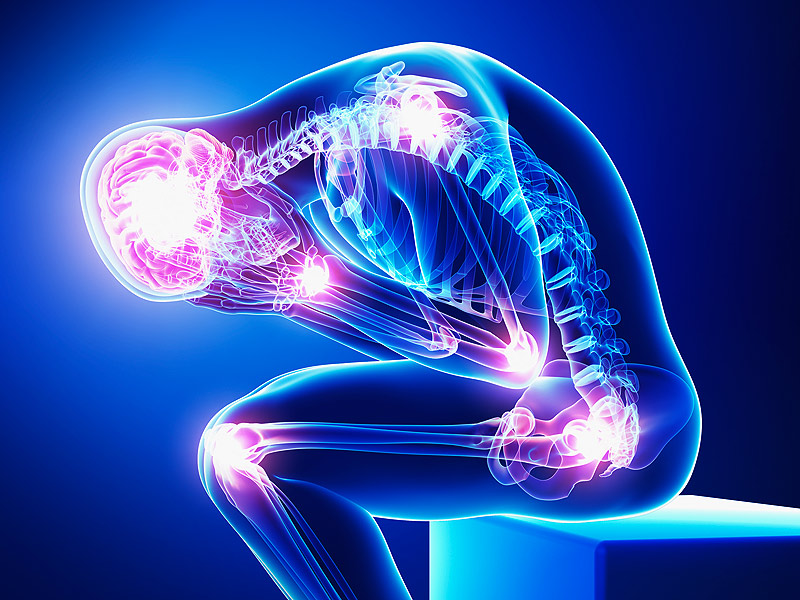Valuable Tips to Manage Pain

While it may be possible to differentiate among three root causes of pain, namely, physical, emotional and post-traumatic pain, they often overlap. Millions of people suffer from various aches and pains after the immediate physical cause (e.g., some structural physical or mechanical change secondary to an accident or injury) was ostensibly dealt with, the expectation being that pain should now subside. However it may last for months on end and become chronic. Emotion may not always be recognized by the medical caregiver as a factor in bringing about structural change, although it is well known to affect us at the level of our physiology, particularly with regard to our neural functioning. Note that in contrast to our innate affects, emotion is learned. It consists of both biology and biography.
Both stress and anxiety may exacerbate pain, especially when we begin wondering what it portends or means (e.g., does our chest pain signify we are having a heart attack? Does this headache point to a serious illness?) While crucial to first rule out medical conditions that might account for the pain— especially when there is concern one may be having a heart attack and each second counts— in general, it may be helpful to remind ourselves that there are many reasons for a given pain, and we need not imagine the worst-case scenario.
When there is a perception of danger that poses a threat to our survival or physical integrity/wholeness, our amygdala, a part of the brain’s limbic system that has been likened to a smoke detector, sounds an alarm. As we orient to danger, we may seek to engage with others, much like animals seek safety in numbers. When the other is unavailable or cannot protect us, we may respond to the threatening situation with anger-rage (Fight response) or with the primary affects of fear-terror or anguish-distress (Flight response).
When activated, fear leads to a bracing response in our body, as it strives to protect itself. Our arms may rise up instinctively to protect our heads or we may curl up into a ball. Unless released, bracing leads to chronic constriction, and eventually, pain. We may then brace against the pain, resulting in more constriction and more pain. We may collapse into helplessness and ‘Freeze.’ Underneath the freeze there lurk both anger-rage and terror-fear, or anguish-distress. Moreover, the freeze may also lead to shame-humiliation, until the patient learns that the freeze is a legitimate innate survival response, the default when neither fight nor flight are feasible.
Under these conditions, the various parts of our brain may no longer function in concert as before, and some of them may shut down temporarily. When our prefrontal cortex is out of commission, there results a lack of integration and coherence among various normally interrelated systems. We may no longer be able to differentiate between our awareness and the contents of our awareness, which include sensations, images, memories, meanings, behaviors and primary affects associated with our pain. This means that we may be consumed by the pain itself— we feel as if we are the pain. It is as if nothing else is.
Thus, it is helpful to keep in mind that each sensation is short-lived, having a beginning, middle and end, and especially, to be able to remind ourselves of this when in the throes of pain. When we are able to become curious about the sensations comprising our pain, we are in effect interrupting or overriding the fear, and in a position to look for meaningful patterns to shed light on our current pain and its vicissitudes.
Given what we know today, it appears likely that unresolved trauma, whether minor or major, plays a role in the persistence of chronic pain, through mechanisms of kindling (a self-perpetuating phenomenon of neural excitation) and priming (in which the brain readies itself to respond a certain way), that cause us to continually brace ourselves against the threat that caused the pain or the internal threat of pain itself. This is great news, because it means that to the extent that the trauma is worked through at the body/mind level, the pain should either disappear or lessen. Whereas initially, the embodied brain (the brain and nervous systems dispersed and located in the body, including the so-called ‘enteric’ or gut brain) may have entered a temporary state of alarm in an adaptive effort to deal with a perceived or real threat, a cascade of events characterized by a self-perpetuating feedback loop may emerge. For balance to be restored, it is necessary to let our nervous system (and especially our amygdala) know that all is now well.
One major way this may occur is when the action plan to deal with the original emergency situation meriting a fight or flight survival response, is allowed to complete— otherwise, the tremendous energy recruited to deal with the emergency, leftover energy that was not used up in fight or flight, has nowhere to go, and is bound in symptoms. This completion of an action schema of fight or flight brings with it a welcome discharge of the survival energy recruited to deal with the emergency. This discharge make take various forms, including shaking and trembling, yawning, spontaneous deep breaths, to name but few. It functions like a ‘reset’ of the body/mind system. This reset, when negotiated correctly in a stepwise, titrated fashion, is a key goal of trauma therapy. To the extent that chronic pain was exacerbated by unresolved trauma, it is released during this reset.
***
It is possible for us to train ourselves to dissect our pain and focus on one painful sensation of constriction at a time. Words describing different pain sensations include: throbbing, burning, tingling, boring, piercing etc. Ultimately this focus on the sensations of pain should help dissipate and release it, although at first, this awareness may actually intensify it.
Another practice we may adopt, is to imagine the opposite of the sensation we are experiencing (it need not make sense but should involve an image of expansion to contradict or counterbalance that of constriction), and then to focus our attention on this new sensation. We should then go back and forth a few times between the two, until the pain subsides.
These are some of the kinds of exercises one may learn and practice in somatic experiencing, a specific form of body-mind therapy. Key to this approach is the tracking of bodily sensations underlying our thoughts, feelings and memories, and learning how to nudge our body/mind to release them, one by one, in a gradual and titrated fashion, an innate, natural process that may have become ‘stuck’ or truncated. This ‘reset’ may require the presence of an attuned therapist trained in this technique.
Since each of us may benefit from different techniques at different times, some experts recommend adding certain breathing exercises to our tool kit for self-soothing and for dismantling pain. These exercises open up pathways of openness and flow in your body, and in thus doing, counteract the constriction prevalent in the fight/flight/freeze responses. One of my favorites is to ride the breath, tracking the entry of air as we breathe and noting the way our chest and abdomen go up and down with each inhalation and exhalation, respectively. Others may prefer a form of circular breathing, where one tracks the air as it progresses from one side of the body to the other. For the latter, it may be worthwhile proceeding clockwise and then counter`clockwise, starting with your right foot and making your way upward to your head and then descending toward your left foot, or vice versa. Start with the side of the body that feels most comfortable.
You can also try the following exercise: make a chant-like ‘Voo’ sound, propelled by the air you breathe, a sound that hovers in the air and expires (in a diminuendo) as the last vestiges of air are expelled. Focus on the vibrations in your belly as you do this. Peter Levine, the creator of SE describes the Voo sound, which he took from Tibetan chants, as the sound of a foghorn, used to alert ship captains they are reaching land, to guide them safely home. He stresses it is important to allow both sound and breath to expire fully, and then await a moment until the next breath enters on its own, when ready. The sound vibrations enliven the viscera (heart and internal organs) and the full expiration ensures an optimal balance of oxygen and carbon dioxide. The sensations of vibration and tingling, may be accompanied by temperature changes, and with practice, should allow you to become calmer and feel more secure. Try it a few times, whether alone or with a partner.



